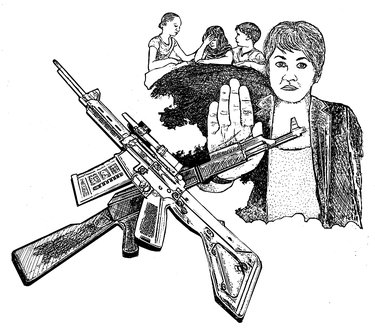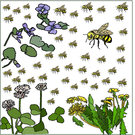Arm our teachers to help, not kill
We were impressed with the courage and honesty of the Voorheesville students who organized last week’s ceremony to honor the 17 victims killed at Marjory Stoneman Douglas High School in Parkland, Florida. Students across the United States were part of a 17-minute walkout a month after the latest school massacre. This Tuesday, a school shooting at Great Mills High School in Maryland marked the 17th this year.
At Voorheesville, the students focused on the need to help one another and to overcome the stigma of mental illness. What they told our New Scotland reporter, Sean Mulkerrin, made clear the important role that schools now play in students’ well-being.
“Sometimes it’s a lot easier to talk to a teacher, because I can’t imagine my mom and dad sitting up and worrying if I am going to hurt myself,” said Alex Ruhren, one of the organizers.
Another of the student organizers, Eryn Payne, admitted that she has done self-harm. “You don’t have to kill yourself to kill the old you,” she said, “because you can be someone you want to be.”
The students said that teachers and administrators at their school are extremely receptive to students’ emotional needs.
We are pleased that New York State is now requiring that mental health be part of the curriculum. Legislation signed in 2016 will take effect in July. The curriculum, still being developed, will help teachers and students recognize the signs of potential problems and reduce the associated stigma.
Such measures are sorely needed. Eight percent of students nationwide have attempted suicide in the past six months, according to the Mental Health Association in New York State. This is part of a disturbing increase in the percentage of young people who have reported having a major depressive episode.
The Centers for Disease Control and Prevention reports that the top three causes of death for people between the ages of 10 and 24 are accidents, suicide, and homicide — causes that kill over six times as many in that age group than the next seven causes of death. Half of all lifetime cases of mental illness begin by ae 14; three-quarters by age 24.
We have on this page since the Columbine shooting in Colorado said that schools should be sanctuaries, not citadels. In 1999, as many school districts rushed to beef up security, installing metal detectors and surveillance cameras and hiring armed officers, we liked the approach taken by Guilderland School Board members and administrators.
The superintendent at the time, Blaise Salerno, spoke to the high school students and the board of the need for “the development of a caring community, one in which we look after each other.” Alluding to the fact that the two boys who caused the Columbine slaughter considered themselves outcasts, Salerno said it was the right of every individual to demonstrate differences and to be accepted. “It is the differences between us that challenge us to be better than we are,” he said.
In the nearly two decades since then, the culture of schools have changed so that surveillance cameras, locked doors, and school resource officers are now often the norm.
We believe the heart of schools — where children learn and grow from their mistakes — should still be trust. In March 2001, after the school killing in Santee, California, we wrote in an editorial called, “Learn the 3 R’s to stop violence”: “It’s happened again. It’s on the front pages of our daily newspapers; it’s on the television and radio news shows. It’s in the back of our minds, on the tip of ur tongues, and in the churning pit of our bellies. More school violence ….”
An all-too-familiar depiction of the 15-year-old boy who had wielded the gun described him as a picked-on outcast. The 3 R’s that the Guilderland schools were teaching in addition to the old reading, writing, and ’rithmetic, were building relationships, respect, and a sense of responsibility.
After the 2012 slaughter at Sandy Hook Elementary School in Littletown, Connecticut, we wrote of a report, “Tending Our Youth,” endorsed by more than 100 organizations representing over four million professionals, including teachers, principals, psychologists, social workers, and mental-health workers.
“Inclination to intensify security in schools should be reconsidered,” the professionals wrote. The report details several successful programs where trust is an underlying tenet.
“Building relationships within and around the school community can help keep school violence from happening while fostering academic success,” the report says. “For students, trusting relationships with adults are critical to learning.”
The president’s plan to arm teachers with guns is the wrong approach. Teachers are nurturers. Their training and efforts should be directed toward teaching, not shooting.
Mass killings have happened in churches. Does it follow, then, that pastors should be armed, too? Shootings have happened in theaters. Should we arm ushers? Mass shootings have happened at a nightclub and outdoor concert. Should we arm singers? The list goes on.
The point is: More guns don’t make us safer. We’re much safer, as a society, when guns are in the hands of trained police.
The money that would be spent to arm and train teachers to kill would be far better spent on more mental-health professionals in the schools. A Siena College poll released this week showed that New York State registered voters strongly oppose — 69 to 28 percent — allowing teachers to be licensed to carry concealed firearms in school.
As Hannah Levitt, a Voorheesville student, pointed out in her speech at last week’s ceremony, many of the mass shootings that have taken place in the past 25 years have been rooted in untreated or poorly treated mental illnesses.
Teaching our kids how to recognize those signs and offering them the help they need would be far more effective than arming teachers with guns.


